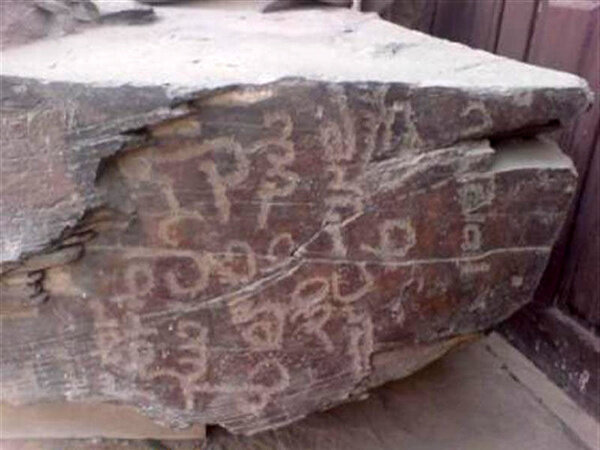Prehistorical petroglyph bearing Pahlavi script discovered in central Iran

TEHRAN – A prehistorical petroglyph, which bears Pahlavi script written by ordinary people of the time, has recently been found during an archaeological survey in Teymareh region of Khomein county, central Iran.
“This is the sixth petroglyph, engraved with Pahlavi script, which has so far been found in the highlands of Teymareh. And the petroglyph is estimated to date back to 2,200 years ago,” IRIB quoted Iranian archaeologist Mohammad Nasserifard as saying on Wednesday.
“The difference between this inscription and other inscriptions of the Pahlavi script discovered in Iran, (which have been inscriptions ordered by monarchs and rulers) is that these manuscripts belong to ordinary people and those who were far from the power and governments,” Nasserifard explained.
Pahlavi is a particular, exclusively written form of various Middle Iranian languages. Pahlavi compositions have been found for the dialects/ethnolects of Parthia, Persis, Sogdiana, Scythia, and Khotan.
Talking about the significance of the relics, the top archaeologist said “From the content of their texts, we can learn about the social and anthropological views of the Iranian people who lived in this region about two millennia ago.”
“Therefore, the texts of these inscriptions are first-hand documents that can help researchers to discover more about the life of ordinary people who lived in this region some 2,200 years ago.”
Back in May, Nasserifard proposed a bold hypothesis on a variety of petroglyphs that are scarred in the region, saying “some prehistorical residents of the Iranian plateau migrated to the Americas.” His assumption is based on evidence from similarities between the petroglyphs and cave painting symbols in central Iran and the ones found in the Americas.
“After years of exploring ancient paintings inside Iran’s caves and mountains and other parts of the globe, amazing achievements have been made in this regard,” Nasserifard said.
“The ancient paintings of cave walls and mountains in Iran have been compared with ones in other parts of the world, their similarities in appearance and motifs have been ‘amazing’, according to quotes by professors Jan Brouwer and Gus van Veen,” Nasserifard explained, adding “His research and findings are presented to enthusiasts and researchers for the first time.”
“Appearance similarities, artistic styles, and uniform themes of ancient petroglyphs and cave paintings of this land (Iran) reveal many missing links in human history and arts one of which is the resemblance of ancient artifacts in Iran with ones found in the American continent.”
Earlier in March, a team of entomologists and archaeologists concluded that a previously-founded petroglyph showcases a six-limbed creature with the head and arms of a praying mantis. The rare 14-centimeter rock carving was first spotted in the Teymareh rock art site during surveys between 2017 and 2018, but could not be identified due to its unusual shape.
Jan Brouwer and Gus van Veen have examined the Teymareh site estimating its carvings were made 40,000-4,000 years ago. Prehistoric rock art provides insights into past eras and cultures as archaeologists classify the tools for the carvings by specific eras Incising tools include flint, metal, or thigh bones of hunted prey.
AFM/MG
